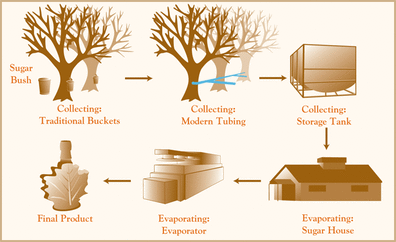
Maple Syrup begins as sap - the watery fluid that circulates through a a maple tree. The sap is harvested when temperatures at night are below freezing but it is above freezing in day time. The sap is then concentrated and filtered into maple syrup.
Syrup produced at the beginning of the season is typically lighter in color and sweeter tasting. It is called 'light' or light amber. As the season progresses, the syrup becomes darker in color and the maple flavor becomes stronger. It first becomes medium amber, then dark amber. After dark amber it becomes 'grade b' syrup, so called because it is not top quality in color but has a strong maple flavor. The stronger the flavor, the less swweter the taste.
Maple syrup contains more calcium then milk, more potassium than a banana, more manganese, iron, and zinc than honey. It has a variety of pleasantly smelling compounds such as vanillin, hydroxybutanone, propionaldehyde, maple furanone, strawberry furanone, and maltol.
Maple syrup also contains antioxidants such as polyphenols including Ginnalins A-C and Quebecol.
